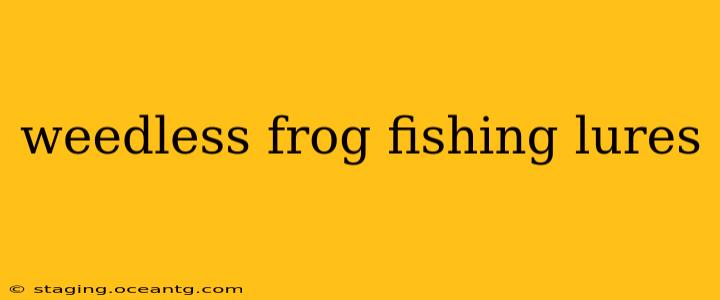Frog lures are a fantastic way to target large bass, especially in heavy cover where other lures just won't reach. But the key to successful frog fishing lies in choosing the right weedless design. This guide will delve into the world of weedless frog lures, exploring different types, techniques, and considerations to help you land that trophy bass.
What Makes a Frog Lure Weedless?
The secret to a weedless frog lies in its design. Most weedless frogs feature a unique construction that allows them to glide through thick vegetation without snagging. This typically involves:
- Weed guards: These are strategically placed, usually silicone or plastic, guards extending from the hook. They protect the hook point from snagging on weeds, lilies, and other obstructions. The length and design of the weed guard vary depending on the specific lure.
- Hook placement: The hook is often positioned underneath the frog's body, minimizing the chances of snagging. Many designs use a weighted hook system to improve penetration.
- Body material: The frog's body is usually made of soft, buoyant material like foam, allowing it to float high in the water column. This helps it navigate over obstacles.
Different Types of Weedless Frog Lures
The market offers a variety of weedless frog lures, each with its own unique characteristics:
- Hollow-body frogs: These are the most common type, known for their buoyant design and excellent weedless capabilities. They often have a larger profile, making them ideal for attracting larger bass.
- Solid-body frogs: These are denser and typically sink faster than hollow-body frogs. They can be effective in deeper water or when a slower presentation is desired.
- Popping frogs: Designed to create a loud popping sound when retrieved, these lures are very effective at attracting bass from a distance.
- Walking frogs: These frogs are designed to walk or glide across the surface, creating enticing side-to-side movements.
How to Fish Weedless Frog Lures
Mastering the technique is crucial for success:
- Target areas: Focus on areas with heavy vegetation like lily pads, hyacinth, reeds, and thick grass.
- Casting: Accurate casting is essential to place the lure precisely within the target zone.
- Retrieval: A slow, steady retrieve is often most effective. Try pausing the lure frequently to allow the bass time to react. Experiment with different retrieves to see what works best. Some anglers prefer a steady retrieve, while others like to incorporate twitches and pops.
- Setting the hook: When you feel a bite, set the hook firmly but avoid oversetting, as this can cause the frog to pull free.
What are the Best Weedless Frog Lures for Beginners?
Many excellent options exist for beginners. Look for frogs with larger weed guards for added protection and a more forgiving design. Consider brands known for their durable and effective weedless designs; research reviews to find suitable choices.
What Size Hooks are Used in Weedless Frogs?
Hook sizes vary depending on the size of the frog and the target species. Generally, larger frogs will use larger hooks. Check the lure packaging for recommended hook size information.
How to Keep Your Weedless Frog Lures Clean?
Regularly clean your weedless frog lures to remove debris and maintain their effectiveness. A soft brush and warm soapy water are generally sufficient. Allow them to dry completely before storage.
Conclusion
Weedless frog lures are a powerful tool for bass fishing in heavy cover. By understanding the different types, techniques, and considerations, you can significantly improve your chances of success and land that coveted trophy bass. Remember to choose the right lure for the conditions and experiment with different retrieves to find what works best. Happy fishing!
